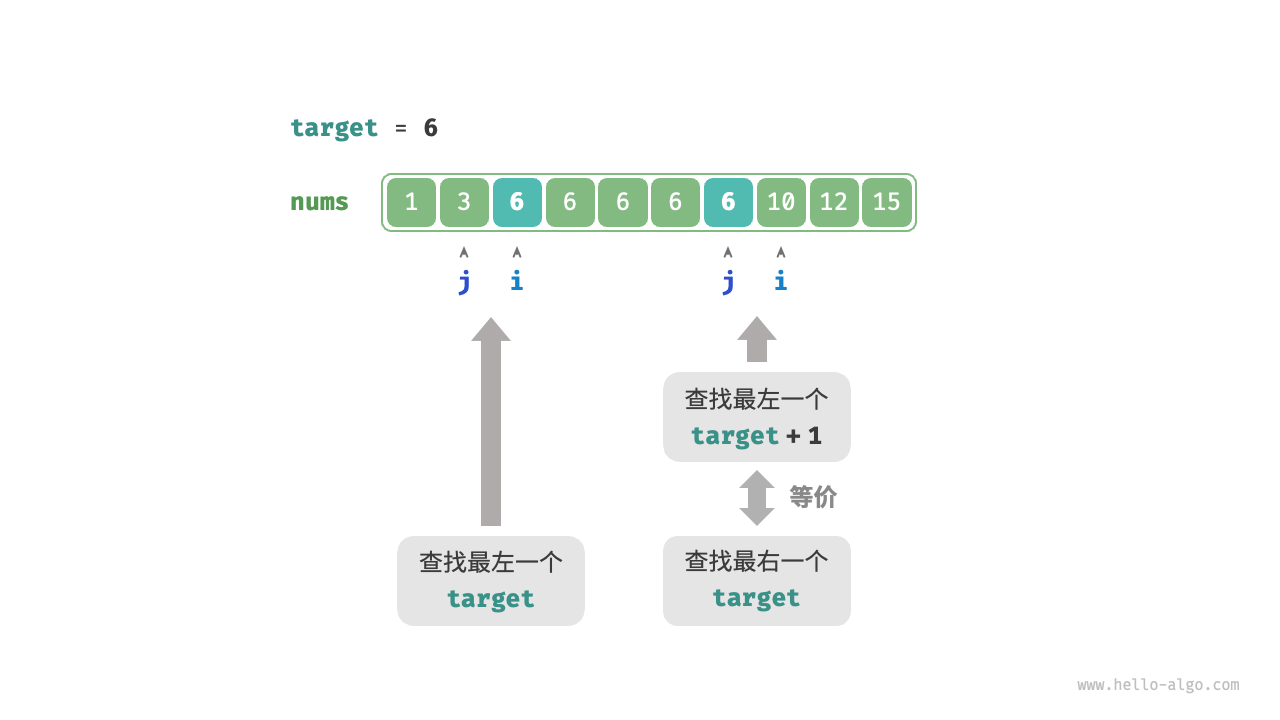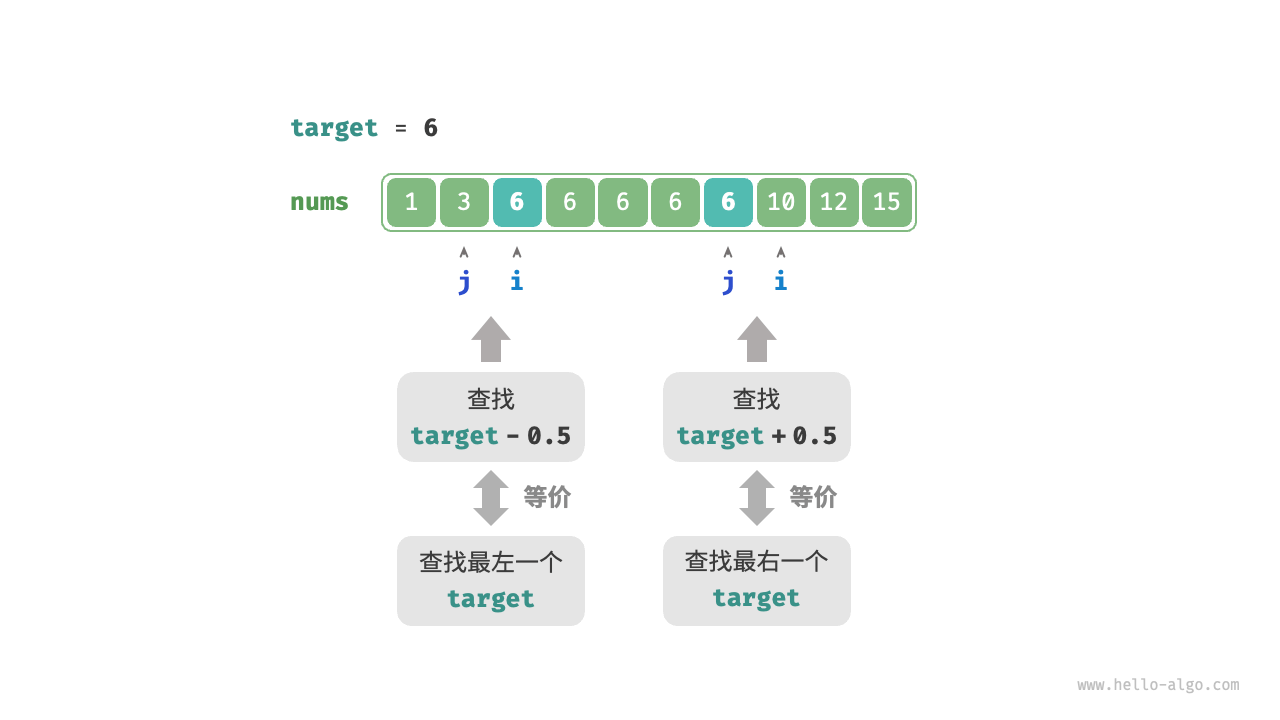10.3 二分查找边界¶
10.3.1 查找左边界¶
Question
给定一个长度为 \(n\) 的有序数组 nums ,其中可能包含重复元素。请返回数组中最左一个元素 target 的索引。若数组中不包含该元素,则返回 \(-1\) 。
回忆二分查找插入点的方法,搜索完成后 \(i\) 指向最左一个 target ,因此查找插入点本质上是在查找最左一个 target 的索引。
考虑通过查找插入点的函数实现查找左边界。请注意,数组中可能不包含 target ,这种情况可能导致以下两种结果。
- 插入点的索引 \(i\) 越界。
- 元素
nums[i]与target不相等。
当遇到以上两种情况时,直接返回 \(-1\) 即可。代码如下所示:
binary_search_edge.ts
/* 二分查找最左一个 target */
function binarySearchLeftEdge(nums: Array<number>, target: number): number {
// 等价于查找 target 的插入点
const i = binarySearchInsertion(nums, target);
// 未找到 target ,返回 -1
if (i === nums.length || nums[i] !== target) {
return -1;
}
// 找到 target ,返回索引 i
return i;
}
可视化运行
10.3.2 查找右边界¶
那么如何查找最右一个 target 呢?最直接的方式是修改代码,替换在 nums[m] == target 情况下的指针收缩操作。代码在此省略,有兴趣的读者可以自行实现。
下面我们介绍两种更加取巧的方法。
1. 复用查找左边界¶
实际上,我们可以利用查找最左元素的函数来查找最右元素,具体方法为:将查找最右一个 target 转化为查找最左一个 target + 1。
如图 10-7 所示,查找完成后,指针 \(i\) 指向最左一个 target + 1(如果存在),而 \(j\) 指向最右一个 target ,因此返回 \(j\) 即可。
图 10-7 将查找右边界转化为查找左边界
请注意,返回的插入点是 \(i\) ,因此需要将其减 \(1\) ,从而获得 \(j\) :
binary_search_edge.py
def binary_search_right_edge(nums: list[int], target: int) -> int:
"""二分查找最右一个 target"""
# 转化为查找最左一个 target + 1
i = binary_search_insertion(nums, target + 1)
# j 指向最右一个 target ,i 指向首个大于 target 的元素
j = i - 1
# 未找到 target ,返回 -1
if j == -1 or nums[j] != target:
return -1
# 找到 target ,返回索引 j
return j
binary_search_edge.cpp
/* 二分查找最右一个 target */
int binarySearchRightEdge(vector<int> &nums, int target) {
// 转化为查找最左一个 target + 1
int i = binarySearchInsertion(nums, target + 1);
// j 指向最右一个 target ,i 指向首个大于 target 的元素
int j = i - 1;
// 未找到 target ,返回 -1
if (j == -1 || nums[j] != target) {
return -1;
}
// 找到 target ,返回索引 j
return j;
}
binary_search_edge.java
/* 二分查找最右一个 target */
int binarySearchRightEdge(int[] nums, int target) {
// 转化为查找最左一个 target + 1
int i = binary_search_insertion.binarySearchInsertion(nums, target + 1);
// j 指向最右一个 target ,i 指向首个大于 target 的元素
int j = i - 1;
// 未找到 target ,返回 -1
if (j == -1 || nums[j] != target) {
return -1;
}
// 找到 target ,返回索引 j
return j;
}
binary_search_edge.cs
/* 二分查找最右一个 target */
int BinarySearchRightEdge(int[] nums, int target) {
// 转化为查找最左一个 target + 1
int i = binary_search_insertion.BinarySearchInsertion(nums, target + 1);
// j 指向最右一个 target ,i 指向首个大于 target 的元素
int j = i - 1;
// 未找到 target ,返回 -1
if (j == -1 || nums[j] != target) {
return -1;
}
// 找到 target ,返回索引 j
return j;
}
binary_search_edge.go
/* 二分查找最右一个 target */
func binarySearchRightEdge(nums []int, target int) int {
// 转化为查找最左一个 target + 1
i := binarySearchInsertion(nums, target+1)
// j 指向最右一个 target ,i 指向首个大于 target 的元素
j := i - 1
// 未找到 target ,返回 -1
if j == -1 || nums[j] != target {
return -1
}
// 找到 target ,返回索引 j
return j
}
binary_search_edge.swift
/* 二分查找最右一个 target */
func binarySearchRightEdge(nums: [Int], target: Int) -> Int {
// 转化为查找最左一个 target + 1
let i = binarySearchInsertion(nums: nums, target: target + 1)
// j 指向最右一个 target ,i 指向首个大于 target 的元素
let j = i - 1
// 未找到 target ,返回 -1
if j == -1 || nums[j] != target {
return -1
}
// 找到 target ,返回索引 j
return j
}
binary_search_edge.js
/* 二分查找最右一个 target */
function binarySearchRightEdge(nums, target) {
// 转化为查找最左一个 target + 1
const i = binarySearchInsertion(nums, target + 1);
// j 指向最右一个 target ,i 指向首个大于 target 的元素
const j = i - 1;
// 未找到 target ,返回 -1
if (j === -1 || nums[j] !== target) {
return -1;
}
// 找到 target ,返回索引 j
return j;
}
binary_search_edge.ts
/* 二分查找最右一个 target */
function binarySearchRightEdge(nums: Array<number>, target: number): number {
// 转化为查找最左一个 target + 1
const i = binarySearchInsertion(nums, target + 1);
// j 指向最右一个 target ,i 指向首个大于 target 的元素
const j = i - 1;
// 未找到 target ,返回 -1
if (j === -1 || nums[j] !== target) {
return -1;
}
// 找到 target ,返回索引 j
return j;
}
binary_search_edge.dart
/* 二分查找最右一个 target */
int binarySearchRightEdge(List<int> nums, int target) {
// 转化为查找最左一个 target + 1
int i = binarySearchInsertion(nums, target + 1);
// j 指向最右一个 target ,i 指向首个大于 target 的元素
int j = i - 1;
// 未找到 target ,返回 -1
if (j == -1 || nums[j] != target) {
return -1;
}
// 找到 target ,返回索引 j
return j;
}
binary_search_edge.rs
/* 二分查找最右一个 target */
fn binary_search_right_edge(nums: &[i32], target: i32) -> i32 {
// 转化为查找最左一个 target + 1
let i = binary_search_insertion(nums, target + 1);
// j 指向最右一个 target ,i 指向首个大于 target 的元素
let j = i - 1;
// 未找到 target ,返回 -1
if j == -1 || nums[j as usize] != target {
return -1;
}
// 找到 target ,返回索引 j
j
}
binary_search_edge.c
/* 二分查找最右一个 target */
int binarySearchRightEdge(int *nums, int numSize, int target) {
// 转化为查找最左一个 target + 1
int i = binarySearchInsertion(nums, numSize, target + 1);
// j 指向最右一个 target ,i 指向首个大于 target 的元素
int j = i - 1;
// 未找到 target ,返回 -1
if (j == -1 || nums[j] != target) {
return -1;
}
// 找到 target ,返回索引 j
return j;
}
binary_search_edge.kt
/* 二分查找最右一个 target */
fun binarySearchRightEdge(nums: IntArray, target: Int): Int {
// 转化为查找最左一个 target + 1
val i = binarySearchInsertion(nums, target + 1)
// j 指向最右一个 target ,i 指向首个大于 target 的元素
val j = i - 1
// 未找到 target ,返回 -1
if (j == -1 || nums[j] != target) {
return -1
}
// 找到 target ,返回索引 j
return j
}
可视化运行
2. 转化为查找元素¶
我们知道,当数组不包含 target 时,最终 \(i\) 和 \(j\) 会分别指向首个大于、小于 target 的元素。
因此,如图 10-8 所示,我们可以构造一个数组中不存在的元素,用于查找左右边界。
- 查找最左一个
target:可以转化为查找target - 0.5,并返回指针 \(i\) 。 - 查找最右一个
target:可以转化为查找target + 0.5,并返回指针 \(j\) 。
图 10-8 将查找边界转化为查找元素
代码在此省略,以下两点值得注意。
- 给定数组不包含小数,这意味着我们无须关心如何处理相等的情况。
- 因为该方法引入了小数,所以需要将函数中的变量
target改为浮点数类型(Python 无须改动)。

